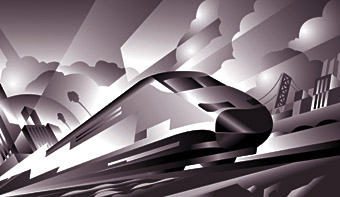Increasing concerns arise over California's high speed rail project

Serious questions are being asked about the viability and affordability of California High Speed Rail. The project was approved by voters in Nov. 2008, allocating almost $10 billion in bonds. When and if completed, it would link San Francisco and Los Angeles with trains capable of going 220 mph, making the trip in 2 ½ hours.
Sounds great, doesn’t it? Most voters, when asked, say they favor such a system.
But would they still favor it if they knew it would cost at least $43 billion?
Given the apocalyptically bad state of the California budget, the money can’t come from California. It doesn’t have any to spare. The federal government has ponied up $2.3 billion so far, and California High-Speed Rail Authority (CHSRA) is asking for $1 billion more. But, this is nowhere near enough, and that $10 billion in bonds has to be paid back with interest, ultimately by you the taxpayer, should the project prove unprofitable.
The Washington Post details a number of serious problems and challenges in building High Speed Rail (HSR.) The rail beds need to be built of concrete not crushed rock. They can’t deviate, even slightly, as that could cause derailment for a train going 200+ mph. Such rail beds are not capable of taking the extreme load of freight trains, thus they are passenger only. With hauling freight not an option, would a L.A.-S.F. route carry enough passengers to pay for itself?
Existing tracks, where presumably HSR rail would be laid, tend to be curvy and cross multiple intersections. HSR would have to slow down substantially on such curves or exercise eminent domain to take land to put in straight tracks. The City of Orange just voted unanimously to oppose HSR, and two primary reasons were eminent domain would take land they want for other purposes, and the track would go through their historic Old Towne.
These are genuine concerns and not mere NIMBYism. As for intersections, HSR can’t go through them because a collision between a fast train and a vehicle would be catastrophic. Thus, HSR either has to go over or under intersections. Either way means massive amounts of eminent domain with existing buildings and homes being razed to allow for HSR.
I can’t think of a better way to get peasants with pitchforks in the streets than by telling local residents, sorry, but we’re planning to bulldoze your homes and businesses, it’s all for the greater good, I’m sure you understand. Actually, they probably won’t.
Sacramento Bee columnist Dan Walters poses further questions about HSR in a KALW interview. The bond money cannot be spent until there is full financing for the system. We are nowhere near that now. Further, the University Of California Institute Of Transportation Studies slammed HSR ridership projections, saying they are unreliable and unrealistic. If that’s true, then private financing will be nearly impossible to get.
Also - and CalWatchdog echoes this with their “Slower Than a Speeding Bullet” - with all the curvy rail lines and being forced to slow down in urban areas plus making multiple stops at stations, will it really be all that fast?
It is also troubling that CHSRA has banned contractors preparing environmental reports from releasing any information to the press, especially since CHSRA gives a patently silly reason for doing so. They say it’s to prevent contractors from billing them for communicating with the press. Well gosh, if that’s an issue, just don’t pay them for it.
But a California State Auditor report in April 2010 was scathing in criticizing CHSRA for their “lax contract management” including not reviewing invoices to ensure the work was performed. Here’s a tip for CHSRA. Read the invoices before you pay them, something which just isn’t rocket science.
High Speed Rail seems like a great idea. But, it will be hugely expensive. That $43 billion estimate will undoubtedly go much higher, especially when the cost of above and below ground tracks is factored in.
It’s difficult to see how it could even be profitable or at the very least, break even.




